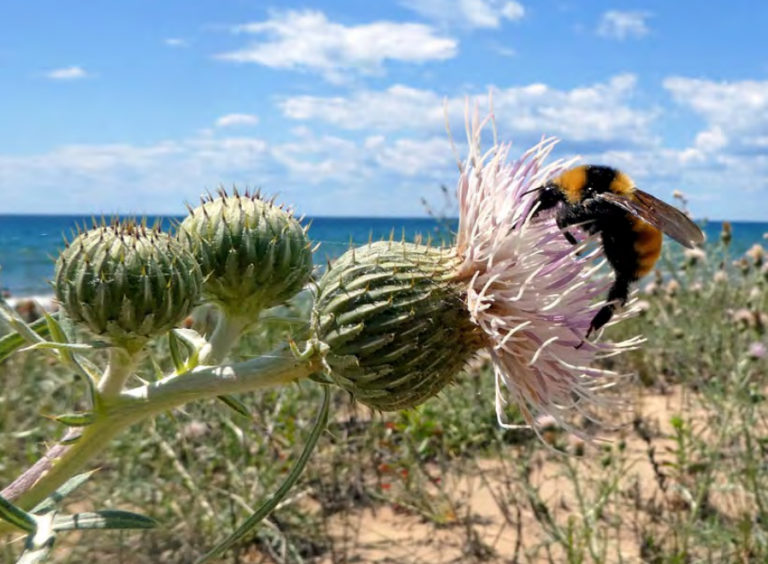Portions of this blog post have been excerpted from our conservation guide Native Thistles: A Conservation Practitioner’s Guide
Native thistles are a largely misunderstood and wrongly maligned group of wildflowers. Often confused with their prickly, invasive relatives such as Canada thistle, in reality, native thistles are benign and valuable plants that fill a variety of significant niches along more esteemed wildflowers such as coneflowers, prairie clovers, and others. While so many of those native wildflowers have been embraced by restoration practitioners, gardeners, and native plant enthusiasts, native thistles haven’t garnered the same enthusiasm, and that’s too bad. With sublime blue-green foliage, interesting stem and leaf architecture, and pink blossoms, our native thistles are every bit as resplendent—and as valuable for wildlife—as countless other native plants. It is time to change our attitudes towards our native thistles and recognize their importance, and the first step to do this is by providing the information for conservation practitioners to plant, protect, and grow these important native plants.

Our native thistles fill important niches in our ecosystems. In great grasslands and prairies, alpine meadows and silty Midwestern river bottoms, the seeds of our native thistles help sustain enormous flocks of songbirds such as goldfinches and indigo buntings. The nectar of these plants fills the stomachs of countless flower visitors, including the enormous black and gold bumble bee (Bombus auricomus), while the foliage of thistles feeds both people and rare butterflies alike. Edible thistle, (C. edule), is a staple food of the Salish people of the Pacific Northwest, while swamp thistle, (C. muticum) is a caterpillar host plant for the endangered swamp metalmark butterfly (Calephelis muticum).
Native Thistles Are Disappearing
As with so many of our other native prairie and meadow species, thistles have been a direct casualty of habitat loss, suffering the effects of loss of native plant communities to agriculture, urbanization and the development of cities and roads. Most significantly, they have suffered from the invasion of non-native thistles as indiscriminate weed control efforts often eradicate native thistles along with their invasive relatives. Many of our policies and activities are heralding the potential end of these beautiful and important plants. A number of native thistle species are now threatened with extinction.
In fact, in response to the spread of exotic invasives such as Canada thistle (C. arvense, an import from Eurasia, not Canada), expansive biocontrol programs have released alien thistle-eating insects that devour invasive and native thistles alike. These biological control efforts have only had limited impacts on some invasive thistles, but likely devastating impacts on our native ones. This pressure has been compounded by farm-level thistle eradication efforts, including the ever-increasing use of herbicides. And finally, some broad-reaching weed control policies treat all members of the genus as noxious weeds, ignoring the potential to push historically common native thistles toward local extinction.

Bringing Thistles Back
Our native thistles deserve to be returned to their rightful place in the landscape. Xerces’ new thistle guide provides the information necessary to do this. In it you’ll find one of the most comprehensive discussions of the value of native thistles for pollinators and other wildlife, as well as a detailed account of the conservation status of native thistles. Given the significance of the invasion of non-native thistles and the ramifications this has had for their native counterparts, we provide a brief history of the arrival, spread, and efforts to control one of the most invasive thistles in North America, Canada thistle. Finally, there is a section on the production of native thistle seed for use in restoration projects, based on multiple years of actual native thistle seed production by the Xerces Society Pollinator Conservation Program in partnership with a fantastic group of native seed companies.
The new Xerces conservation guide was designed to provide the tools necessary to help public land managers, native seed producers, and landowners take the next steps to conserve and protect this beautiful and important group of native plants.
Further Reading
Read the conservation guide Native Thistles: A Conservation Practitioner’s Guide
Read the brochure A Guide to Iowa's Native Thistles



